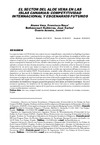Please use this identifier to cite or link to this item:
https://accedacris.ulpgc.es/jspui/handle/10553/56090
| Title: | El sector del aloe vera en las Islas Canarias: competitividad internacional y escenarios futuros | Other Titles: | Le secteur de l’aloès véra aux Îles Canaries: compétitivité internationale et scénarios futurs Setor de aloe vera nas Ilhas Canárias: competitividade internacional e os cenários futuros Aloe vera industry in the Canary Islands: international competitiveness and future scenarios |
Authors: | Alamo Vera, Francisca Rosa Bethencourt Gutiérrez, José Carlos Osorio-Acosta, Javier |
UNESCO Clasification: | 530404 Comercio exterior | Keywords: | Aloe vera Competitividad territorial Diamante nacional Dinámica de sistemas Escenarios, et al |
Issue Date: | 2016 | Journal: | Agroalimentaria | Abstract: | Las exportaciones a la UE del aloe vera canario son casi insignificantes, aun siendo el archipiélago la primera región europea en cultivo y producción de esta planta, con unos diez millones de ejemplares adultos que serían suficientes para satisfacer la demanda total de Europa. Por tal motivo, el presente trabajo tiene como objetivo el análisis de la competitividad regional de Canarias en el sector del aloe vera, empleando como marco conceptual el diamante de Porter, modelo seleccionado para este estudio por su potencial para ser aplicado a sectores de muy distinta naturaleza y extraer resultados coherentes sobre las bases de la ventaja competitiva de un sector que tienen su origen en el territorio. Este estudio es, además, debidamente complementado con la identificación e interpretación de variables que representan influencias externas a la industria a través del análisis PEST. Posteriormente, tomando como referencia las conclusiones de este diagnóstico, se hace uso de la dinámica de sistemas para proyectar escenarios sobre la posible evolución futura de indicadores socioeconómicos básicos del sector, a fin de estudiar el impacto que determinadas decisiones estratégicas de nivel sectorial ejercería sobre el desarrollo competitivo de esta industria, aspirando a una demanda más amplia. En estos escenarios entra en juego el papel desempeñado por el sector turístico, analizándose las beneficiosas sinergias que podrían generarse entre ambas actividades económicas. Así, en el escenario optimista, los beneficios de las empresas del sector del aloe se verían significativamente incrementados con la innovación y mejora de los productos, acciones publicitarias, y convenios con hoteles y otros establecimientos turísticos. Exportation to EU of aloe vera from The Canary Islands are nearly inexistent, although the archipelago is the leading European region in the farming and production of this plant with some ten million adult plants, what would be enough to satisfy the whole demand in Europe. Based on these arguments, this working paper has the aim of analysing regional competitiveness of The Canary Islands in the aloe vera industry, by applying Porter’s diamond as the methodological framework. This model was selected because it can be used in different sectors to obtain consistent results about the competitive advantage bases of an individual industry that are located in the territory. Additionally, the previous study is complemented with a PEST analysis for the identification and interpretation of those variables that represent external influences to the industry. Drawing on the conclusions of these two diagnoses, systems dynamics is used to elaborate scenarios on the possible future evolution of basic socio-economic indicators for the industry, in order to study the impact that specific industrial strategic decisions might have on the competitive development of the sector, aiming to a higher demand. In the scenarios tourism industry plays a key role, and the beneficial synergies between both economic activities are analysed. Thus, the results in the optimistic scenario show that business profits in the aloe vera industry would be significantly higher through the innovation and improvements in products, advertisement, and cooperation with hotels and other tourism agents. |
URI: | https://accedacris.ulpgc.es/handle/10553/56090 | ISSN: | 1316-0354 | Source: | Agroalimentaria [ISSN 1316-0354], v. 22 (42), p. 59-79 | URL: | http://dialnet.unirioja.es/servlet/articulo?codigo=6040050 |
| Appears in Collections: | Artículos |
Page view(s)
287
checked on Dec 14, 2024
Download(s)
360
checked on Dec 14, 2024
Google ScholarTM
Check
Share
Export metadata
Items in accedaCRIS are protected by copyright, with all rights reserved, unless otherwise indicated.
